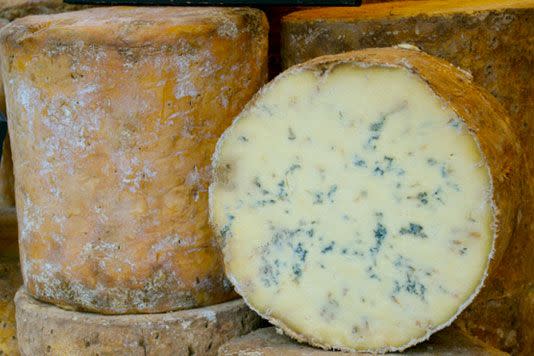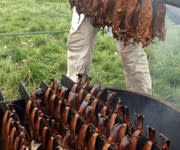What’s in a name? Discovering Protected Food Names

And that means more than just 'Pretty Good Ingredient'. In fact, PGI stands for Protected Geographical Indication, and it is one of three marks which the EU can award to a European food or drink to give it legal protection against imitation. Put bluntly, this golden seal of approval means no-one else can make that product, unless they meet the exact same standards set by the original producer.
The three golden seals
Since The EU Protected Food Names (PFN) Scheme launched in 1993, 48 UK food and drink producers have successfully applied for one of three stamps. Let’s deal with the trio in alphabetical order.
Protected Designation of Origin (PDO)

Examples: Cornish Clotted Cream, Jersey Royal Potatoes, Stilton Cheese.
To call your product Cornish Clotted Cream, you must produce, process and prepare it in Cornwall; and the features of your clotted cream must be due to it being made in Cornwall (so, you must use milk from Cornish cows, for example).
Protected Geographical Indication (PGI)

Examples: Herefordshire Perry, Dorset Blue Cheese, Cornish Pasty.
To call your product Herefordshire Perry, you must produce, process or prepare it in Herefordshire; and the features of your Herefordshire Perry must have a local reputation, or certain features/qualities attributable to Herefordshire.
Traditional Speciality Guaranteed (TSG)

Examples: Gloucester Old Spot Pig and Traditional Farmfresh Turkey.
This one’s a bit different. The TSG mark is open to products which are traditional or have customary names, and have features which distinguish them from other similar products. But these features do not have to be attributable to a certain area.
…so it sounds like PDO is the gold medal, PGI is silver, and TSG (there are only two TSG products in the UK) brings up the rear with bronze. But it’s damn hard work to get even a TSG.
Patience is a virtue
It’s not just a case of writing a nice letter to the EU folks pleading your case. With good reason – the process has to be robust, or else too many products would be awarded a golden seal –, it can take up to two years for a product to become registered. And there are about 10 stages to the process, including 12 months for the commission team to examine the application. The award for Melton Mowbray Pork pie took 11 years! It is the EU Standing Committee who has the final say.
But then again, the food producers who apply for PFN status are usually passionate, driven sorts, who would happily spend two years for the cause. Let’s take the example of Arbroath smokies, who were awarded their PGI in 2004…
The Arbroath Smokies example

What is an Arbroath smokie? It’s haddock, which are dry-salted in tubs; tied by the tail in pairs and hung on sticks; placed over a half whisky barrel, which is burning a beech and oak hardwood fire; then smoked until golden brown. Authentically the fish is then eaten straight from the barrel.
The Spink family uses only this method (which dates back to the 1800s) to make their smokies at Arbroath, a Scottish town on the North Sea coast. So you can understand why founder Bob Spink (his son Iain now runs the firm) was so hacked off when a fishery in Cornwall also started to sell ‘Arbroath Smokies’, despite the fact that they were made in Cornwall, and smoked in large, electric kilns. Applying for PFN status was, it seemed, the only way to stop this travesty.
When they were awarded their PGI eight years ago, Bob said: “At last, after this lengthy process, we have a major success story to shine a light in the gloom that has been the recent lot of the fish processing industry…This recognition from Europe will ensure the quality, tradition, and identity of the Arbroath Smokie”
…and so the Cornish Arbroath Smokie was no more.
Introducing Irene Bocchetta

So I’ve decided to try and get PFN status for my St Albans lemon drizzle cake. What do I do first? How do I fill out the application form? Thank goodness for Irene Bocchetta, the EU Protected Food Names Manager at ADAS, who gives UK producers making PFN applications a helping hand. I caught up with her to dig a little deeper into the PFN issue.
How many food producers are successful with their applications?
The role of ADAS is to vet each application. I talk to the applicant group, meet with them and find out if their product could meet the criteria of a protected food name. Based on that, the success rate is high because the ground work is thorough. When an application does not progress it is normally because the applicant has decided not to carry on with the application – it’s a totally producer-lead process.
Why does the UK only have 40-odd PFN products, while places like Italy have over 200?
The UK has a pretty poor history when it comes to documenting food, whereas other European countries like Italy have been doing it so well for hundreds of years. So you see, when in 1993 it came to registering products for PFN status, Italy already had the documentation to refer to, so filling out the paperwork was relatively easy. The UK on the other hand had little to work with. Take Swaledale cheese, for example. That’s a 400 year-old recipe, but because it wasn’t well documented hardly anybody had heard of it, and so applying for its PFN status was harder.
Is it worth going through such a lengthy process to get PFN status?

It is lengthy, but definitely worth it. The thing is, once you’re protected by a PDO, PGI or TSG mark, no other producer can even give their product a similar name, let alone the same one. There’s no getting away with it. Now that Melton Mowbray Pork Pies have PGI status for example, supermarkets can no longer pass off fluorescent pork pies as Mowbray pies. Which is, of course, a good thing!
Alas I don't think my drizzle cake will be gold-sealed anytime soon. But I'd still like to be involved. We can all help by buying PFN food and drink, which directly supports local producers and will ensure that you’re buying a top notch product. For a list of all the PFN products in the UK, check out Irene’s very helpful and colourful map.
Did you know what PFN products were before you read this? Have you any to nominate? And should we be pushing more through, faster? Talk to us in the Comments Box below…


